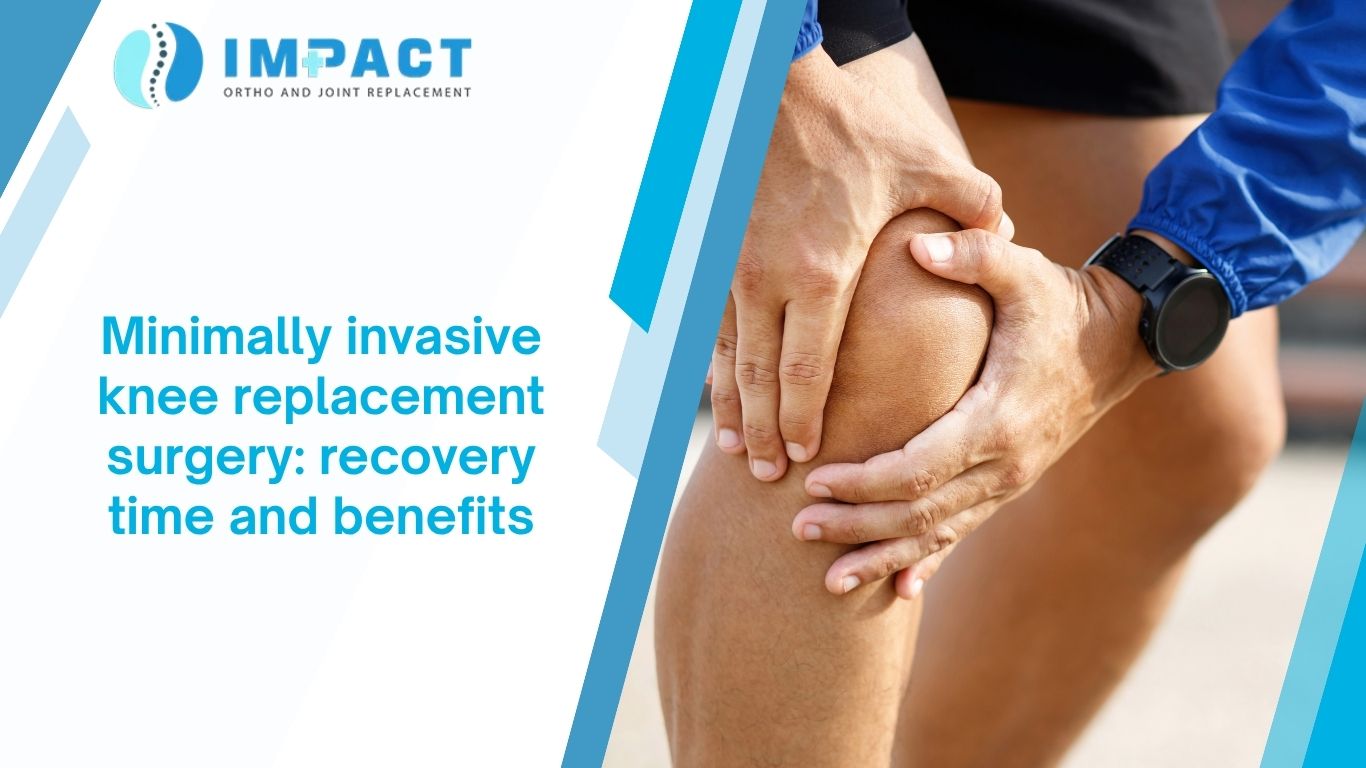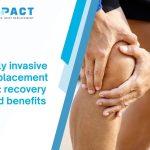Choosing to undergo a total knee replacement (TKR) is a momentous decision, one that signifies your commitment to overcoming chronic pain and regaining your mobility. The technology and surgical techniques used today have advanced remarkably, making the procedure safer and more effective than ever before. At the forefront of this evolution is Minimally Invasive Knee Replacement Surgery (MIKRS).
This technique is often misunderstood as simply a smaller incision. In reality, it represents a profound shift in surgical philosophy, prioritizing tissue preservation and accelerated post-operative recovery. For anyone asking about their quality of life after surgery, understanding the core benefits and the potential reduction in recovery time offered by Minimally Invasive Knee Replacement Surgery is absolutely essential.
This guide will thoroughly explore what MIKRS is, how it differs from traditional methods, and exactly what the patient journey looks like, focusing heavily on the rapid rehabilitation protocols that define this modern procedure.
What Defines Minimally Invasive Knee Replacement Surgery?
The primary distinction between traditional TKR and MIKRS is not the size of the skin incision (though it is usually shorter), but rather the management of the critical soft tissues underneath, especially the powerful quadriceps muscle and its tendon.
The Shift from Traditional to Minimally Invasive
In a traditional TKR, the surgeon often needs to make a long incision and temporarily cut through or extensively dissect the quadriceps tendon and associated structures to gain the necessary wide-open view of the knee joint. This provides excellent visualization but results in significant trauma to the main engine of the knee.
Minimally Invasive Knee Replacement Surgery aims to spare these structures:
- Quadriceps Sparing: The core of MIKRS involves accessing the joint around the quadriceps tendon, rather than through it. This technique, known as the medial parapatellar or subvastus approach, minimizes or eliminates cutting the muscle and tendon fibers.
- Smaller Incision: The skin incision is typically $4$ to $6$ inches long, compared to $8$ to $12$ inches for traditional surgery. This leads to a better cosmetic result and less scarring.
- Precision through Technology: Because the smaller incision limits the visual field, MIKRS is often performed using advanced technology like computer navigation or robotics. These systems provide the surgeon with real-time, objective data, ensuring the necessary accuracy of bone cuts and implant placement, even through a confined working space.
This preservation of the quadriceps mechanism directly translates into less pain, better early function, and a noticeably faster initial recovery time.
Section 2: The Clinical and Functional Benefits
The anatomical advantages of avoiding major muscle dissection manifest as concrete patient benefits that shape the entire post-operative experience. Understanding these benefits is key to appreciating the value of Minimally Invasive Knee Replacement Surgery.
1. Reduced Post-Operative Pain
Since the quadriceps tendon is the primary structure involved in weight-bearing and knee extension, trauma to this area is the major source of initial surgical pain.
- Less Tissue Trauma: By preserving the muscle and tendon integrity, MIKRS drastically reduces the source of pain. This means patients often require fewer and lower doses of strong opioid pain medication immediately after the procedure.
- Better Early Motion: With less muscle pain, patients are psychologically and physically more able to bend and straighten the knee right away, which is crucial for preventing stiffness.
2. Faster Muscle Activation and Strength Return
This is arguably the greatest benefit of Minimally Invasive Knee Replacement Surgery.
- Immediate Weight-Bearing: Patients can typically put their full weight on the knee much sooner because the main extensor mechanism (the quad) has not been compromised.
- Quicker Strength: The leg muscles can be activated and strengthened earlier in the rehabilitation process, leading to accelerated milestones.
3. Less Blood Loss and Reduced Hospital Stay
The smaller incision and reduced soft-tissue trauma mean fewer vessels are cut. This results in less blood loss, lowering the risk of needing a blood transfusion. Coupled with better pain control and earlier mobility, this allows many patients to participate in Enhanced Recovery After Surgery (ERAS) protocols, leading to discharge sometimes as early as the same day or the next morning (for outpatient TKR candidates), or within 1 to 3 days maximum.
4. Improved Patient Satisfaction and Cosmetic Outcome
The smaller incision naturally results in a smaller, less noticeable scar, which is an important cosmetic benefit. More importantly, the feeling of the knee being “stronger” sooner contributes greatly to overall patient satisfaction. Patients feel less like they are starting from zero in their recovery.
Section 3: The Accelerated Recovery Time and Timeline
The term “recovery time” is relative. While the final recovery time to reach maximum strength and endurance remains about 6 to 12 months, Minimally Invasive Knee Replacement Surgery dramatically shortens the time required to regain independence and return to major daily functions.
Here is a typical timeline for the accelerated recovery time seen with MIKRS:
Phase 1: Immediate Post-Operative (Day 0 to Day 7)
- Goal: Early mobilization, pain control, and avoiding stiffness.
- Key Milestones:
- Day 0 (Surgery Day): Walking with crutches or a walker within hours of surgery. Starting continuous passive motion (CPM) or simple range-of-motion exercises.
- Day 1-3: Discharged home (especially in modern orthopedic centers that follow ERAS principles). Ability to get in and out of bed/chairs independently and navigate stairs with assistance.
- MIKRS Advantage: Due to the quadriceps sparing, the initial pain and weakness are significantly muted, allowing the patient to achieve the $90^\circ$ knee bend milestone much faster.
Phase 2: Early Home Rehabilitation (Week 2 to Week 6)
- Goal: Eliminating assistive devices and focusing on gait normalization.
- Key Milestones:
- Week 2: Often able to drive (if the surgery was on the left knee and they drive an automatic car). Incision is fully healed, and sutures/staples are removed.
- Week 4: Often transitioning from a walker to a cane, and eventually eliminating all assistive devices (walking independently).
- Week 6: Reaching approximately of knee flexion.
- MIKRS Advantage: Recovery time for walking without assistance is often reduced by 1 to 2 weeks compared to traditional surgery because the primary stabilizer muscle is intact.
Phase 3: Strength and Endurance Building (Month 2 to Month 4)
- Goal: Full range of motion, return to low-impact sports.
- Key Milestones:
- Month 2: Beginning moderate strengthening exercises, including light weights, stationary biking, and swimming. Return to non-strenuous work.
- Month 3: Able to perform most activities of daily living without noticing the knee. Full range of motion should be close to or completely recovered.
- MIKRS Advantage: Strength gains happen faster because the early weeks weren’t spent recovering from quad-tendon incision; they were spent strengthening the already preserved muscle.
Phase 4: Full Recovery (Month 6 to Month 12)
- Goal: Maximum functional improvement, return to all approved activities.
- Key Milestones: Final swelling resolves, and bone remodeling around the implant is complete. This is the point where the patient achieves the full, long-term benefits of the surgery.
It is crucial to emphasize that while MIKRS shortens the initial recovery time—the time until independence—diligence in physical therapy over the entire six-month period is still required to lock in the long-term success of the joint.
🦵 Get Back on Your Feet — Experience Pain-Free Movement Again!
Considering a Minimally Invasive Knee Replacement?
Learn everything about recovery time, benefits, and how our specialists help you return to daily activities faster with advanced knee care.
✔ Meet top knee specialists | ✔ Minimally invasive techniques | ✔ Faster recovery programs
⚡ Limited free consultation slots available — book yours today!
Section 4: The Technology Behind Minimally Invasive Accuracy
A key aspect of Minimally Invasive Knee Replacement Surgery is that the small incision cannot compromise the accuracy of the surgery. In fact, MIKRS often requires more technology to ensure a perfect result.
1. Computer Navigation and Robotics
As mentioned, the reduced visual field of the MIKRS approach necessitates advanced guidance systems to ensure precise alignment.
- Real-Time Feedback: Robotic platforms (like Mako, ROSA, or others) use pre-operative CT scans and reflective trackers attached to the patient’s leg to create a map of the knee. During surgery, the system verifies every bone cut, ensuring it is within sub-millimeter accuracy of the optimal planned position.
- Balancing: These systems also allow the surgeon to precisely tension the collateral ligaments—the critical step in achieving a stable, natural-feeling knee. This precision is difficult to achieve manually through a small incision.
2. Specialized Instrumentation
MIKRS requires purpose-designed instruments that are smaller, angled, and often extend past the incision to perform the necessary surgical steps without damaging the surrounding soft tissues. This evolution in tools is fundamental to the ability to preserve the quadriceps mechanism while still preparing the bone for implantation.
Section 5: The Ideal Candidate and Potential Limitations
While the benefits of Minimally Invasive Knee Replacement Surgery are compelling, it is not appropriate for every patient. This is an important consideration for managing expectations and achieving the fastest recovery time.
Patient Selection Criteria
The best candidates for MIKRS generally possess:
- Moderate Deformity: Patients with severe, fixed varus (bow-legged) or valgus (knock-kneed) deformities may require larger exposures to safely correct the limb’s alignment.
- Lower Body Mass Index (BMI): Excessive soft tissue bulk makes access through a small incision technically challenging and carries a higher risk of complications (like wound issues or poor visibility).
- No Severe Scarring: Patients who have had prior surgeries or significant trauma to the knee may have scarred tissue that limits the possibility of safely navigating around the quadriceps tendon.
The surgeon must weigh the potential for a faster recovery time against the paramount need for perfect alignment. If a patient’s anatomy requires a slightly larger exposure to achieve better alignment, the surgeon will prioritize the alignment every time, as misalignment is the number one cause of long-term implant failure.
Section 6: Post-Operative Management for Optimized Recovery
Achieving the short recovery time promised by Minimally Invasive Knee Replacement Surgery requires a committed partnership between the patient and the care team, especially concerning post-operative management.
The Role of Physical Therapy
Even with MIKRS, physical therapy is not optional; it is accelerated. Because the muscles are less damaged, the therapist can often be more aggressive with range-of-motion and strengthening exercises earlier. The patient must be dedicated to their daily home exercise program to capitalize on the muscle-sparing benefits and maintain the early gains achieved.
Pain Management for Mobility
As discussed, MIKRS reduces initial pain. This advantage must be maintained by aggressive, multi-modal pain management (nerve blocks, scheduled non-opioid medications, and localized injections). The goal of pain management is simple: keep the patient comfortable enough to do their physical therapy effectively. A comfortable patient is a mobile patient, and mobility is the fastest route to a full recovery time.
In conclusion, Minimally Invasive Knee Replacement Surgery represents a significant step forward, offering compelling benefits including less pain, reduced scarring, and notably shorter initial recovery time compared to traditional methods. By preserving the crucial quadriceps mechanism and leveraging cutting-edge technology for precision, surgeons can deliver excellent outcomes and a quicker return to independence. The surgeons at Impact Ortho are specialists in the most advanced, tissue-sparing techniques and utilize robotic guidance to ensure every patient receives the full benefits of modern orthopedic care. For those seeking the fastest and most comfortable path back to an active life, the commitment to technological excellence at Impact Ortho makes them a leading choice for Minimally Invasive Knee Replacement Surgery.
Frequently Asked Questions (FAQs)
Does a smaller incision mean less accurate surgery?
Absolutely not. Historically, this was a concern, but modern Minimally Invasive Knee Replacement Surgery relies heavily on computer navigation or robotics. These technologies compensate for the reduced visibility, ensuring the components are placed with greater accuracy (sub-millimeter precision) than is often achievable with manual methods.
How soon can I return to driving after MIKRS?
If your right knee (the driver’s foot) was operated on, you should not drive for at least 4 to 6 weeks, or until you are completely off pain medication and your strength has returned sufficiently to react quickly in an emergency. If your left knee was operated on and you drive an automatic car, you may be cleared to drive within 2 weeks. Always consult your surgeon first.
Is MIKRS the same as Partial Knee Replacement (PKR)?
No. A Partial Knee Replacement (PKR) only replaces one compartment of the knee (usually the inner side). Minimally Invasive Knee Replacement Surgery is a Total Knee Replacement (TKR)—it replaces all three compartments (the end of the femur, the top of the tibia, and the back of the kneecap). The MIKRS term simply refers to the technique used to access the joint (muscle-sparing) rather than the scope of the implant.
Will the faster recovery time lead to less durable results?
The durability of the implant (how long it lasts) is determined by the materials used and the accuracy of the component placement, not the incision size. Since MIKRS often uses robotic or navigation technology to achieve greater accuracy than traditional methods, the long-term wear and stability are often optimized, leading to excellent longevity.
How much range of motion can I expect after MIKRS?
Range of motion is determined by the pre-operative stiffness, the specific implant design, and your dedication to physical therapy. While the MIKRS approach facilitates earlier motion, most patients aim for flexion. The greatest advantage is the speed at which you achieve that functional motion due to reduced pain and muscle inhibition.
Can patients with severe knee deformities receive MIKRS?
It is possible, but often not recommended. Severe deformities require extensive soft tissue releases to straighten the leg. Attempting these complex balancing moves through a small, minimally invasive incision increases the risk of error and may cause more soft tissue damage than a traditional approach. The surgeon will always prioritize correcting the alignment over keeping the incision small.
🦵 Get Back on Your Feet — Experience Pain-Free Movement Again!
Considering a Minimally Invasive Knee Replacement?
Learn everything about recovery time, benefits, and how our specialists help you return to daily activities faster with advanced knee care.
✔ Meet top knee specialists | ✔ Minimally invasive techniques | ✔ Faster recovery programs
⚡ Limited free consultation slots available — book yours today!











